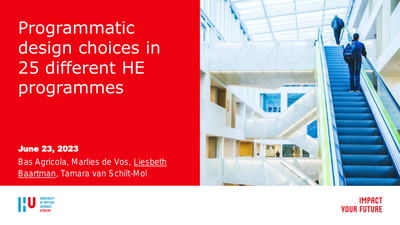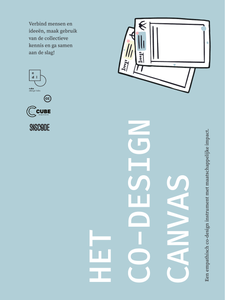A growing number of higher education programmes in the Netherlands has implemented programmatic assessment. Programmatic assessment is an assessment concept in which the formative and summative function of assessment is intertwined. Although there is consensus about the theoretical principles of programmatic assessment, programs make various specific design choices, fitting with their own context. In this factsheet we give insight into the design choices Dutch higher education programmes make when implementing programmatic assessment.
DOCUMENT

Assessment in higher education (HE) is often focused on concluding modules with one or more tests that students need to pass. As a result, both students and teachers are primarily concerned with the summative function of assessment: information from tests is used to make pass/fail decisions about students. In recent years, increasing attention has been paid to the formative function of assessment and focus has shifted towards how assessment can stimulate learning. However, this also leads to a search for balance between both functions of assessment. Programmatic assessment (PA) is an assessment concept in which their intertwining is embraced to strike a new balance. A growing number of higher education programmes has implemented PA. Although there is consensus about the theoretical principles that form the basis for the design of PA, programmes make various specific design choices based on these principles, fitting with their own context. This paper provides insight into the design choices that programmes make when implementing PA and into the considerations that play a role in making these design choices. Such an overview is important for research purposes because it creates a framework for investigating the effects of different design choices within PA.
DOCUMENT

In programmatic assessment (PA), an arrangement of different assessment methods is deliberately designed across the entire curriculum, combined and planned to support both robust decision-making and student learning. In health sciences education, evidence about the merits and pitfalls of PA is emerging. Although there is consensus about the theoretical principles of PA, programs make diverse design choices based on these principles to implement PA in practice, fitting their own contexts. We therefore need a better understanding of how the PA principles are implemented across contexts—within and beyond health sciences education. In this study, interviews were conducted with teachers/curriculum designers representing nine different programs in diverse professional domains. Research questions focused on: (1) design choices made, (2) whether these design choices adhere to PA principles, (3) student and teacher experiences in practice, and (4) context-specific differences between the programs. A wide range of design choices were reported, largely adhering to PA principles but differing across cases due to contextual alignment. Design choices reported by almost all programs include a backbone of learning outcomes, data-points connected to this backbone in a longitudinal design allowing uptake of feedback, intermediate reflective meetings, and decision-making based on a multitude of data-points made by a committee and involving multi-stage procedures. Contextual design choices were made aligning the design to the professional domain and practical feasibility. Further research is needed in particular with regard to intermediate-stakes decisions.
LINK
The design of health game rewards for preadolescents Videogames are a promising strategy for child health interventions, but their impact can vary depending on the game mechanics used. This study investigated achievement-based ‘rewards’ and their design among preadolescents (8-12 years) to assess their effect and explain how they work. In a 2 (game reward achievement system: social vs. personal) x 2 (game reward context: in-game vs. out-game) between-subjects design, 178 children were randomly assigned to one of four conditions. Findings indicated that a ‘personal’ achievement system (showing one’s own high scores) led to more attention and less frustration than a ‘social’ achievement system (showing also high scores of others) which, in turn, increased children’s motivation to make healthy food choices. Furthermore, ‘out’-game rewards (tangible stickers allocated outside the game environment) were liked more than ‘in’-game rewards (virtual stickers allocated in the game environment), leading to greater satisfaction and, in turn, a higher motivation to make healthy food choices.
LINK
Academic design research often fails to contribute to design practice. This dissertation explores how design research collaborations can provide knowledge that design professionals will use in practice. The research shows that design professionals are not addressed as an important audience between the many audiences of collaborative research projects. The research provides insight in the learning process by design professionals in design research collaborations and it identifies opportunities for even more learning. It shows that design professionals can learn about more than designing, but also about application domains or project organization.
DOCUMENT

Introduction: Visuospatial neglect (VSN) is common after stroke and can seriously hamper everyday life. One of the most commonly used and highly recommended rehabilitation methods is Visual Scanning Training (VST) which requires a lot of repetition which makes the treatment intensive and less appealing for the patient. The use of eHealth in healthcare can increase options regarding improved treatment in the areas of patient satisfaction, treatment efficacy and effectiveness. One solution to motivational issues might be Augmented Reality (AR), which offers new opportunities for increasing natural interactions with the environment during treatment of VSN. Aim: The development of an AR-based scanning training program that will improve visuospatial search strategies in individuals affected by VSN. Method: We used a Design Research approach, which is characterized by the iterative and incremental use of prototypes as research instruments together with a strong human-centered focus. Several design thinking methods were used to explore which design elements the AR game should comply with. Seven patients with visuospatial neglect, eight occupational therapists, a game design professional and seven other healthcare professionals participated in this research by means of co-creation based on their own perspectives. Results: Fundamental design choices for an AR game for VSN patients included the factors extrinsic motivation, nostalgia, metaphors, direct feedback, independent movement, object contrast, search elements and competition. Designing for extrinsic motivation was considered the most important design choice, because due to less self-awareness the target group often does not fully understand and accept the consequences of VSN. Conclusion: This study produced a prototype AR game for people with VSN after stroke. The AR game and method used illustrate the promising role of AR tools in geriatric rehabilitation, specifically those aimed at increasing the independence of patients with VSN after stroke. 2020 The Authors. Publishing services by Elsevier B.V. on behalf of KeAi Communications Co. Ltd. This is an open access article under the CC BY-NC-ND license (http://creativecommons.org/licenses/by-nc-nd/4.0/).
DOCUMENT

Het Co-Design Canvas is een instrument om samenwerkingen rondom maatschappelijke uitdagingen met verschillende betrokkenen open en transparant te starten, plannen, uitvoeren en evalueren. Het biedt een hulpmiddel aan overheden, burgers, bedrijven, non-profitorganisaties, kennisinstellingen en andere belanghebbenden om helder te kunnen communiceren en samenwerken. Het maakt verschillen in belangen, kennis, ervaring en machtsverhoudingen inzichtelijk, staat vanaf het begin stil bij gewenste positieve impact en concrete resultaten en zorgt ervoor dat ieders stem echt gehoord wordt.
MULTIFILE

In this paper we explore the influence of the physical and social environment (the design space) son the formation of shared understanding in multidisciplinary design teams. We concentrate on the creative design meeting as a microenvironment for studying processes of design communication. Our applied research context entails the design of mixed physical–digital interactive systems supporting design meetings. Informed by theories of embodiment that have recently gained interest in cognitive science, we focus on the role of interactive “traces,” representational artifacts both created and used by participants as scaffolds for creating shared understanding. Our research through design approach resulted in two prototypes that form two concrete proposals of how the environment may scaffold shared understanding in design meetings. In several user studies we observed users working with our systems in natural contexts. Our analysis reveals how an ensemble of ongoing social as well as physical interactions, scaffolded by the interactive environment, grounds the formation of shared understanding in teams. We discuss implications for designing collaborative tools and for design communication theory in general.
MULTIFILE

Author supplied from the article: ABSTRACT Increasing global competition in manufacturing technology puts pressure on lead times for product design and production engineering. By the application of effective methods for systems engineering (engineering design), the development risks can be addressed in a structured manner to minimise chances of delay and guarantee timely market introduction. Concurrent design has proven to be effective in markets for high tech systems; the product and its manufacturing means are simultaneously developed starting at the product definition. Unfortunately, not many systems engineering methodologies do support development well in the early stage of the project where proof of concept is still under investigation. The number of practically applicable tools in this stage is even worse. Industry could use a systems engineering method that combines a structured risk approach, concurrent development, and especially enables application in the early stage of product and equipment design. The belief is that Axiomatic Design can provide with a solid foundation for this need. This paper proposes a ‘Constituent Roadmap of Product Design’, based on the axiomatic design methodology. It offers easy access to a broad range of users, experienced and inexperienced. First, it has the ability to evaluate if knowledge application to a design is relevant and complete. Secondly, it offers more detail within the satisfaction interval of the independence axiom. The constituent roadmap is based on recent work that discloses an analysis on information in axiomatic design. The analysis enables better differentiation on project progression in the conceptual stage of design. The constituent roadmap integrates axiomatic design and the methods that harmonise with it. Hence, it does not jeopardise the effectiveness of the methodology. An important feature is the check matrix, a low threshold interface that unlocks the methodology to a larger audience. (Source - PDF presented at ASME IMECE (International Mechanical Engineering Congress and Exposition
DOCUMENT

This paper discusses two studies - the one in a business context, the other in a university context - carried out with expert educational designers. The studies aimed to determine the priorities experts claim to employ when designing competence-based learning environments. Designers in both contexts agree almost completely on principles they feel are important. Both groups emphasized that one should start a design enterprise from the needs of the learners, instead of the content structure of the learning domain. However, unlike business designers, university designers find it extremely important to consider alternative solutions during the whole design process. University designers also say that they focus more on project plan and desired characteristics of the instructional blueprint whereas business designers report being more client-oriented, stressing the importance of "buying in" the client early in the process.
DOCUMENT
